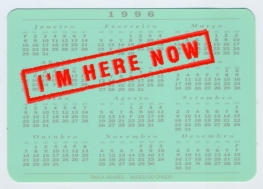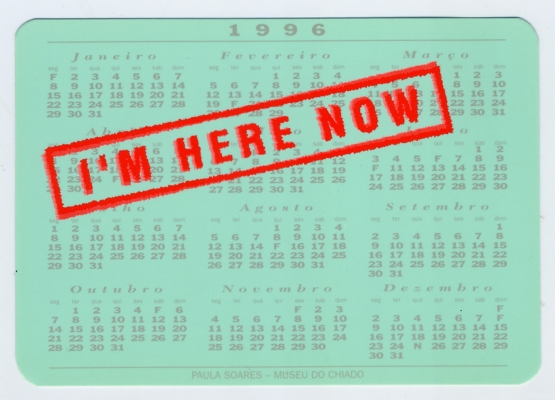
Paula Soares: I'm Here Now (1996)
© DGPC
Bar Gallery
entry: General ConditionsI'm Here Now
Paula Soares
1996-02-28
1996-04-21
Curatorship: Pedro Lapa
We're All Here Now
"The calf" by Tomás da Anunciação is a late-Romantic painting, 1873, in the animalist style which, by descriptive attention to biological aspects as well as by the natural light which illuminates the background, anticipated the Naturalism which was to prevail in Portuguese painting in the last quarter of the 19th century. The impasto chromatic surfaces, which depict the animal fur, display more than the mimetic transposition of a visual sensation to the painting - as created by the real - a skill which defines a specific understanding, supposedly original, of the picture itself and what makes it unique, as is emphasized by the signature.
According to Walter Benjamin this unique existence of a work of art in the place in which it is set, which can be designated as the here and now, constitutes its authenticity and authority or aura. The reproductiveness to which photography is subject, substitutes the unique event by the mass event, removing the emphasis from the work itself and placing it on its reception. Every subject stimulates feelings by direct impact which the unique character of the work bestows, and which is not impeded by the privilege of ownership.
Besides the effect which this situation creates in the divulging of works of art, artists have come to think of it as the conscience of the work in relation to its position in the socioeconomic exchange system, substituting the value of exchange for the value of utilization. Rather than an extention of the social field of art, created by this situation, photography allows the increase in the value role produced by the unique and material character of the pictorial gesture, fulfilled in the construction of the subject and function of this fiction on the exchange system, to be questioned.
The substitution of the painting - sanctified in the museum - by the photograph inscribes the first intentionality of a social nature in this exhibition by Paula Soares. The insertion of the title (I'm here now) by substituting the signature increases and subverts the latent effect. Once the during Modernism the signature, in the absence of transparency in the work of art and of objective order in the world of representation, participates and assumes subjectivity in the opacity of the painting or inscribes the value of the originality of the work. In this work by Paula Soares the title, in declaring the basic singularity of the aura of a work of art, though in a medium which denies it, generates an apparently curious paradox.
The appropriation of a Romantic work - a movement which claimed the concept of originality for itself - radicalizing deconstructive presuppositions, questions the very concept of originality which will eventually be the constitutive centre of the questions previously asked. The falsity of romantic originality in a painting like O vitelo by Tomás de Anunciação cannot stand up to a more detailed analysis which considers its genealogy as a web of relationships formed by continuous renovations. Thus, the similarity of this picture to others painted by Constant Troyon which Anunciação had seen in Paris is very obvious, and Dutch animalist painting, at the turn of the century, primarily that of Paulus Potter and Aelbert Cuyp, is not dissimilar. There is, therefore, a continual reappropriation that goes beyond the presupposition of apparent novelty. It is the very notion of originality which fades, once the original copy is a copy of another copy. As Rosalind Krauss has demonstrated, the originality of a work of art is closely linked to the constitution of the myth of novelty on which Modernism was based and which, in the present work, is subjected to a demystifying criticism which is founded on repetition.
The here and now of the title of this photograph ironically assumes an opposite sense to that of the definition of authenticity, by inscribing the circumstances of the event in the present, yet with an implicit awareness of its conceptual and operative dimension. Attention to the reception and circulation of the work as a concept is increased by the gift to the public of a calendar where the inscription is twice inscribed, in that of the execution of the painting and that of the execution of the photograph, juxtaposed by the same title, reinforcing the sense of the up-to-date as an affirmation of the present and its possibilities. Another aspect which stems from the appropriation and recontextualization of the work is that of a possible metaphoric dimension to which the image of naturalist presupposition is submitted, not only by the fact that it is linked with other works of an allegorical nature by Paula Soares, but most of all by a combination of the operations mentioned. The calf suggests the concept of potentiality as opposed to the deed. And as such supposes an awareness of its renovation in a temporal flow, the title, which contributes to this, is not a replacing of the transparency of signs according to a previously announced order, but the realization of new horizons of possibility which is always implied by a work of art. The circumstantiality and its historic awareness constitutes the assumption of an operative potentiated form which encourages the multiple relations of art with life itself.
On Exhibition
Mily Possoz. A poetics of space
2025-10-01
2026-02-01
Curatorship: Emília Ferreira
The exhibition “Mily Possoz. A Poetics of Space” continues the research into the lesser-studied Portuguese modernists artists present in the collections of the MNAC and Millennium bcp.
Impressões Digitais. MNAC Collection
2024-12-12
2026-12-30
Curatorship: Ana Guimarães, Emília Ferreira, Maria de Aires Silveira e Tiago Beirão Veiga
Consisting of founding works of contemporary Portuguese art historiography, from 1850 to the present day, the MNAC's collection holds several national treasures.
Since 1911
2022-05-26
2026-05-26
An intervention that celebrates 110 years of the MNAC.










